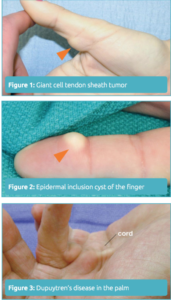Price: $2,500.00
CPT Code: 26116
Hand and Wrist Tumors
Any abnormal lump or bump in the hand or wrist is considered a tumor. The term “tumor” does not necessarily mean it is malignant or that it is a cancer. In fact, most hand and wrist tumors are benign (not cancer). Tumors can occur on the skin, such as a mole or a wart, or underneath the skin in the soft tissue or even the bone. Because there are so many types of tissue in the hand (e.g. skin, fat, ligaments, tendons, nerves, blood vessels, bone, etc.), there are many types of tumors that can occur. Only a few of them are seen commonly.
Common Types of Tumors
• Ganglion Cysts: This is the most common tumor in the hand and wrist. Ganglion cysts are seen frequently in the wrist but can occur at the base of the fingers or around the finger joints. The cyst is typically filled with fluid, and it will feel very firm. There are several treatment options for a ganglion cyst, including observation (doing nothing), aspiration (puncturing with a needle) or surgically removing it.
• Giant cell tumor of the tendon sheath (Figure 1): This is the second most common hand tumor. Unlike the fluid-filled ganglion cyst, these tumors are solid. They are benign (not cancer) and slow-growing.
• Epidermal inclusion cyst (Figure 2): This tumor is benign and forms just underneath the skin where there may have been a cut or puncture. The cyst is lled with keratin, a soft, waxy material.
There are other less common types of tumors seen in the hand, including lipomas (fatty tumors), neuromas (nerve tumors), nerve sheath tumors, bromas and glomus tu- mors, among others. Almost all are benign.
Causes
Foreign bodies, such as a splinter, can cause reactions that form bumps in the hand. Dupuytren’s Contracture may cause rm bumps in the hand, which are often confused with tumors (Figure 3). Finally, blood vessel growths can also be confused with other tumors.
Diagnosis
A physical exam and review of your medical history by a hand surgeon can help to determine the type of hand or wrist tumor you may have. X-rays might be taken to evaluate the bones, joints and possibly the soft tissue. Further studies such as ultrasound, CT, MRI or bone scans may be done to help narrow down the diagnosis. Needle biopsy or incisional biopsy (cutting out a small sample of the tumor) may be considered if the surgeon wants to confirm the diagnosis before recommending treatment.
Treatment
Typically, the most successful treatment is removing the tumor with surgery. This allows a pathologist to analyze it and to determine the type of tumor. Often, surgery is done on an outpatient basis. Some patients may choose to do nothing and simply live with the tumor once they learn that it is non-cancerous. However, if the tumor changes (e.g. skin discoloration, pain, increased size) or if it causes other problems such as numbness or pain from pressure on a nearby nerve, then re-evaluation by a hand surgeon is recommended. You and your hand surgeon can choose the best treatment plan.
© 2015 American Society for Surgery of the Hand
